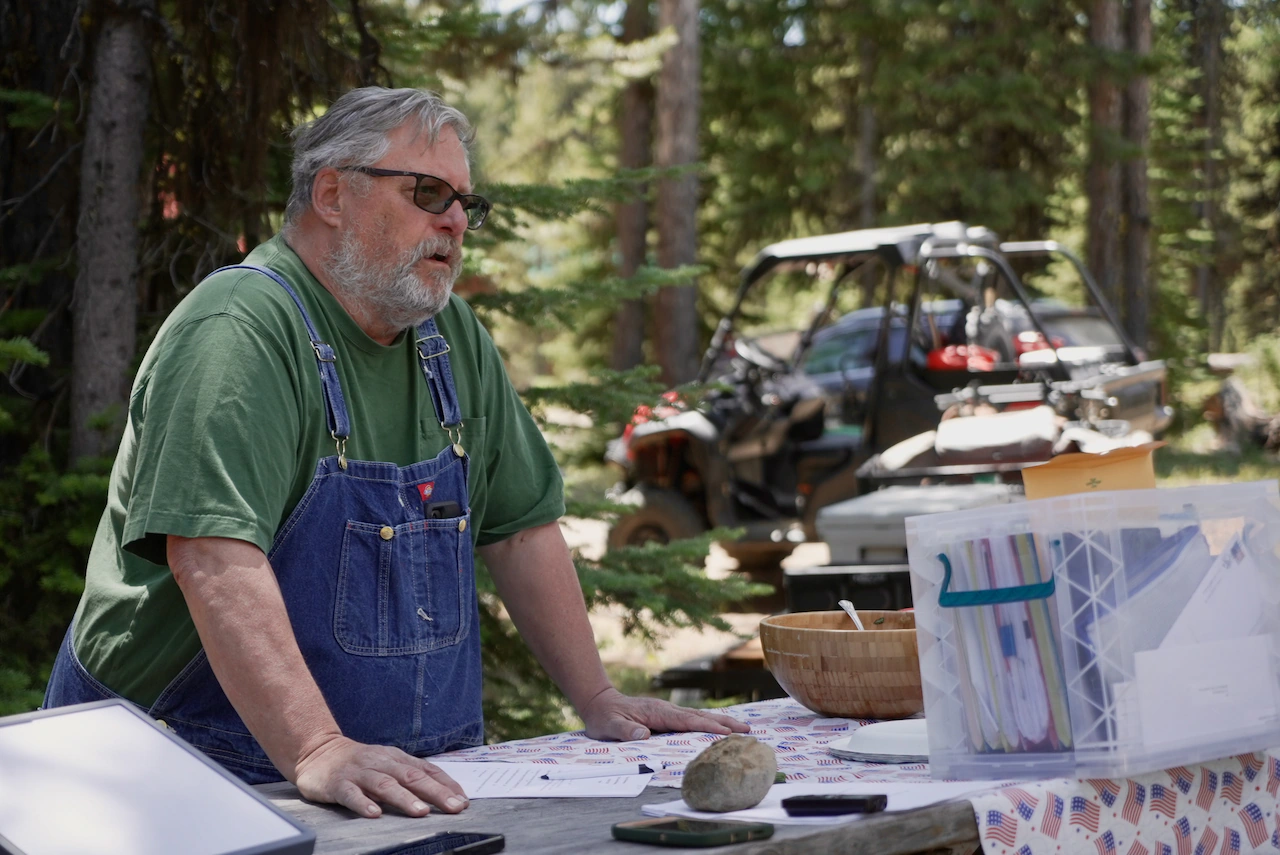
This is the last in a series of stories visiting the five smallest cities in Oregon.
On July 5, about a dozen people in folding chairs gathered in a field. They filled up on hot dogs and potato salad before Mayor Dennis Koellermeier knocked a fist-sized rock on a picnic table to gavel in the start of the annual Greenhorn City Council meeting.
This is how Oregon’s tiniest town keeps itself going.
Oregon’s smallest incorporated city, Greenhorn was home to just three people in the 2020 census but currently has a year-round population of zero. The city’s water system serves about 15 cabins, most occupied only in the summer.
The last family who tried to stay in the unplowed city through the winter gave up two years ago.
“You’ve got to be pretty hardy because four months out of the year, you get here by snowmobile,” said Koellermeier, who lives primarily in West Linn. “Last winter we had 12 feet of snow up here.”
Greenhorn is on the border of Grant and Baker counties in eastern Oregon, about 50 miles west of Baker City and 14 miles south of Granite, the state’s fourth smallest city. Greenhorn is also Oregon’s highest incorporated city, situated at 6,271 feet elevation in the Greenhorn Mountains.
Greenhorn was a gold mining town, and locals will tell you two versions of how the city got its name.
The first is for a jutting mountain bluff of serpentine, a green-hued rock found in the area.
The second is about two young fellas who came to town during the mining years.
“They were drinking in a saloon,” said Arne Olsen, a local who’s been spending his summers in Greenhorn since 1964. “All these miners look at these guys, shoe clerks, these paper ass kids, and they asked, ‘Where can we find gold?’ All these drunks in there go, ‘You go right up on that mountain, on that one ledge up there.’ So they went, and they struck. They struck it rich. So, they named the town after those two greenhorns.”
Which version is true?
“I kind of believe those two shoe clerk kids that went up there,” Olsen said. “It’s got character.”
Koellermeier just laughed.
In Greenhorn, he said, “Everybody’s got a story, and some of them are even true.”
In the book “Oregon’s Golden Years,” author Miles Potter wrote that between 200 and 300 people lived in the Greenhorn area in the 1870s. The town had a hotel, saloon, drugstore, meat market and post office.
The city was incorporated in 1903. In 1912, it became the rare city to receive a townsite patent passed by an act of Congress. President William H. Taft signed the patent granting Simeon Richardson, the mayor of Greenhorn at the time, and his successors the townsite in trust for “the use and benefit of the occupants of townsite of Greenhorn.” The patent secured water rights to a set of springs above the town.
But just a few years later, the mines had closed down and eventually, the town died off, too.
“Greenhorn lasted until Dec. 15, 1919, when the post office closed,” Potter wrote. “Sagebrush crept back into the streets, wind whistled through broken windows, and pack rats set up shop in once-busy stores. Then came a fire that wiped out many of the buildings.”
Greenhorn remained desolate until the 1960s, when people started buying property for summer homes.
“The need for water resurfaced as people started revamping old cabins or building new ones,” Koellermeier said, “ so a group of people took it on to re-start the city.”
Suddenly, that presidential patent became very important.
Because of the patent’s existence, Greenhorn residents argued the city’s incorporated rights were never actually rescinded when the city ceased to function, and in 1971, they held elections for a new city government.
Baker County argued the elections were illegal, and after a series of legal challenges, a Circuit Judge in 1983 ordered the ouster of Greenhorn’s mayor, police chief, city treasurer and city manager because they only owned summer cabins at Greenhorn and actually lived in Portland, West Linn, La Grande and Medford.
To resolve the issue later that same year, the Oregon Legislature passed House Bill 2991. Dubbed the “ghost town bill,” it established a new category of incorporated city called “historic ghost town” and set up the appointment system still in use today.
Every four years, Baker County commissioners appoint three Greenhorn city councilors. Those three then appoint two more, and the five of them choose a mayor.
“We keep the city going because it keeps the water rights going,” Koellermeier said.
Because most property owners visit only in the summer, the city council meets just once a year, over Fourth of July weekend. Predictably, the water system is the main point of discussion.
Greenhorn doesn’t collect any municipal taxes beyond an annual fee for the water system. During July’s meeting, city councilors voted to increase those fees to help build up a fund for water system repairs. Like most of the smallest cities, federal and state grants are a big part of funding major infrastructure.
“To put a thousand feet of waterline in, we need $32,000, and we got the $2,000,” Koellermeier said during the meeting. “So, to start chipping away at that – we’re looking at grants, obviously – I think we need to consider a rate increase.”
Starting in July 2026, property owners will pay $150 a year for water service, or $75 a year if they don’t have a water hookup. In 2027, those rates will increase to $200 for properties with water and $100 for those without.
And that’s all they’ll pay for water for the year. Property owners aren’t charged for water use.
The town has no sewer system (most people have outhouses or septic), no electric or gas lines (people use solar panels or generators), and no mail service.
The main forms of recreation are hunting, fishing and ATV riding along nearby Vinegar Hill.
“There’s a lot of four wheelers and four-wheeler clubs,” Koellermeier said. “On a Sunday there’ll be 20 or 30 coming through town.”
Riders will often stop in Greenhorn to access the sole public space: a restroom.
Greenhorn, Oregon
Population in 2020 census: 3
Size: 0.1 square miles
City budget: $44,484 (which includes $40,000 in grants)
Interesting fact: Because of the town’s gold mining history, many locals will search for gold in the creeks with sluice boxes as a source of entertainment. Small pieces of gold can still be found, along with small garnets.
“Just little jeweler’s garnets,” Koellermeier said. “They’re not very big, but they’re easy enough to find, and the kids get a kick out of it.”



